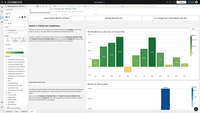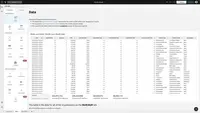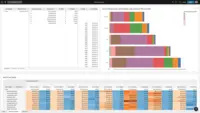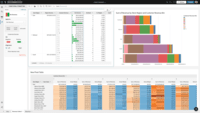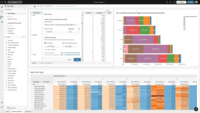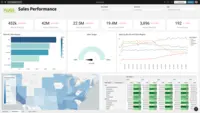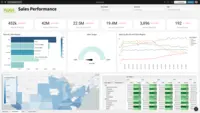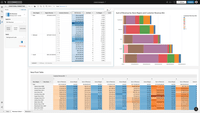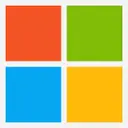Overview
What is Sigma?
Sigma Computing headquartered in San Francisco provides a suite of data services such as code free data modeling, data search and explorating, and related BI and data visualization services.
Great tool with some weird kinks
Sigma Recommended.
Sigma Rolling Out.
My Sigma Review
Sigma Review
Nearly perfect, missing some nice to have features
I tell everyone about Sigma!
Great BI tool loved by many business stakeholders
A data analysis tool that is easy implement and easy to learn.
Love Sigma
Getting data into your users' hands quickly and easily
Excellent Tool for Business Analysis
Actionable and fun data analytics
Sales Ops Usage
How Sigma Differs From Its Competitors
Self-Service Analytics
Ad Hoc Analytics
Self-Service Analytics
Ad Hoc Analytics
Self-Service Analytics
Ad Hoc Analytics
Self-Service Analytics
Ad Hoc Analytics
Self-Service Analytics
Self-Service Analytics
Ad Hoc Analytics
Sigma Computing SQL Knowledge
Dashboards
Sigma Collaboration
Sigma Access Speed
Sigma Computing SQL Knowledge
Dashboards
Sigma Collaboration
Sigma Access Speed
Sigma Computing SQL Knowledge
Sigma Collaboration
Sigma Access Speed
Sigma Computing Pricing Model
Sigma Computing SQL Knowledge
Dashboards
Sigma Collaboration
Sigma Access Speed
Sigma Computing SQL Knowledge
Sigma Collaboration
Sigma Access Speed
Sigma Computing Pricing Model
Awards
Products that are considered exceptional by their customers based on a variety of criteria win TrustRadius awards. Learn more about the types of TrustRadius awards to make the best purchase decision. More about TrustRadius Awards
Popular Features
- Drill-down analysis (150)8.585%
- Report sharing and collaboration (156)8.282%
- Customizable dashboards (155)7.777%
- Formatting capabilities (157)7.373%
Reviewer Pros & Cons
Pricing
What is Sigma?
Sigma Computing headquartered in San Francisco provides a suite of data services such as code free data modeling, data search and explorating, and related BI and data visualization services.
Entry-level set up fee?
- Setup fee optional
Offerings
- Free Trial
- Free/Freemium Version
- Premium Consulting/Integration Services
Would you like us to let the vendor know that you want pricing?
153 people also want pricing
Alternatives Pricing
What is Microsoft Power BI?
Microsoft Power BI is a visualization and data discovery tool from Microsoft. It allows users to convert data into visuals and graphics, visually explore and analyze data, collaborate on interactive dashboards and reports, and scale across their organization with built-in governance and security.
What is Tableau Desktop?
Tableau Desktop is a data visualization product from Tableau. It connects to a variety of data sources for combining disparate data sources without coding. It provides tools for discovering patterns and insights, data calculations, forecasts, and statistical summaries and visual storytelling.
Features
BI Standard Reporting
Standard reporting means pre-built or canned reports available to users without having to create them.
- 7Pixel Perfect reports(100) Ratings
Pixel Perfect reports are highly-formatted reports with graphics and ability to preview the report before printing.
- 7.7Customizable dashboards(155) Ratings
Customizable dashboards are dashboards providing the builder some degree of control over the look and feel and display options.
- 7.1Report Formatting Templates(127) Ratings
Ad-hoc Reporting
Ad-Hoc Reports are reports built by the user to meet highly specific requirements.
- 8.5Drill-down analysis(150) Ratings
Drill down analysis is the ability to get to a further level of detail by going deeper into the hierarchy.
- 7.3Formatting capabilities(157) Ratings
Ability to format output e.g. conditional formatting, lines, headers, footers.
- 7.3Integration with R or other statistical packages(5) Ratings
Integration with the open-source R predictive modeling environment.
- 8.2Report sharing and collaboration(156) Ratings
Report sharing and collaboration is the ability to easily share reports with others.
Report Output and Scheduling
Ability to schedule and manager report output.
- 9.3Publish to Web(99) Ratings
- 8.1Publish to PDF(124) Ratings
- 9.4Report Versioning(114) Ratings
Report versioning is the assignment of version numbers to each version of a report to help in tracking.
- 9.2Report Delivery Scheduling(127) Ratings
Report Delivery Schedule is the ability to have reports delivered to a destination at a specific data and time.
- 8.3Delivery to Remote Servers(64) Ratings
Ability to deliver reports to remote servers
Data Discovery and Visualization
Data Discovery and Visualization is the analysis of multiple data sources in a search for patterns and outliers and the ability to represent the data visually.
- 7.3Pre-built visualization formats (heatmaps, scatter plots etc.)(141) Ratings
Pre-built visualization formats are canned visualization types that can be selected to visualize different kinds of data.
- 5.6Location Analytics / Geographic Visualization(26) Ratings
Location analytics is the visualization of geographical or spatial data.
- 6.2Predictive Analytics(18) Ratings
Predictive Analytics is the ability to build forecasting models based on existing data sets.
Product Details
- About
- Integrations
- Competitors
- Tech Details
- Downloadables
- FAQs
What is Sigma?
Sigma is a business intelligence (BI) and analytics platform purpose-built for the cloud. With Sigma, anyone can use the spreadsheet functions and formulas they already know to explore live data at cloud scale, down to the lowest grain of detail. Its familiar spreadsheet-like interface delivers SQL into the hands of any user while keeping data fresh and secure within cloud data warehouses.
Data-first companies can use Sigma to empower their employees, customers, and partners to break free from the confines of the dashboard and explore data for themselves to make better, faster decisions. The software was built to capitalize on the performance power of cloud data warehouses to combine data sources and analyze billions of rows of data instantly – no coding required.
Sigma Features
BI Standard Reporting Features
- Supported: Pixel Perfect reports
- Supported: Customizable dashboards
- Supported: Report Formatting Templates
Ad-hoc Reporting Features
- Supported: Drill-down analysis
- Supported: Formatting capabilities
- Supported: Predictive modeling
- Supported: Report sharing and collaboration
Report Output and Scheduling Features
- Supported: Publish to Web
- Supported: Publish to PDF
- Supported: Output Raw Supporting Data
- Supported: Report Versioning
- Supported: Report Delivery Scheduling
- Supported: Delivery to Remote Servers
Data Discovery and Visualization Features
- Supported: Pre-built visualization formats (heatmaps, scatter plots etc.)
Sigma Screenshots
Sigma Videos
Sigma Integrations
Sigma Competitors
Sigma Technical Details
| Deployment Types | Software as a Service (SaaS), Cloud, or Web-Based |
|---|---|
| Operating Systems | Unspecified |
| Mobile Application | Mobile Web |
| Supported Countries | United States, Canada |
Sigma Downloadables
Frequently Asked Questions
Comparisons
Compare with
Reviews and Ratings
(287)Attribute Ratings
Reviews
(1-11 of 11)- Visualization of Data
- Ability to Drill Down to Data
- Exporting Data is very easy
- Creation of new data elements, tables and visualizations is easy
- Ability to download a table as an image instead of taking a screenshot
Good enough, worth spending time with.
- Pivot tables, allowing user control for navigating summary/detail views of data
- Visualization
- Speed to delivering dashboard, we have generally been quick to at least prototype dashboards
- Smart comprehension and options for date, numeric and text fields.
- The interface is busy with multiple modes to accomplish similar tasks, so not always intuitive to do some tasks
- While a more specific case of my first point, the relationship between different screen elements is particularly not obvious
- On chart annotation, allowing comments that overlay chart data
Sigma seemed comparable to other tools in the space and what won us over was how quickly we could spin up a dashboard.
- Reduced learning curve compared to other products
- User friendly interface
- Very responsive support chat
- Communicating errors and why they happen
- Preventing users from performing functions that commonly cause errors
- East coast support times
Moving date filters have been tough for Sigma to handle with the nature of our datasets. We have daily ledgers that are only useful one day at a time (and bank dates only), but the preset dates filters are better suited for date ranges (i.e. the "last month" filter is 7/1/2022 to 7/31/2022, while we would just want 7/31/2022). We tend to need to get creative with our functions to get moving dates to work.
Constantly Improving with Sigma Computing
- Easy visualization creation
- Customizable charts
- Relationships between dataset fields
- Cross database datasets
- Filtering using the charts (Like Actions in Tableau)
- Usage of containers within Workbooks / Dashboards to organize content
- Easily sharing spreadsheets (usually heavy) with business users that will be automatically updated
- Creating simple dashboards for easy data exploration
Scenarios where is less appropriate:
- Heavy lifting scenarios where more complex calculations are needed
- Scenarios where cross database joins for datasets are needed or querying big tables
An excellent tool for fostering BI Self-Service Culture
- Calculate aggregations.
- Easy-to-use interface.
- Managing roles and users.
- LOD calculations.
- Filtering in dashboards.
- Joins in workbooks.
A great tool for data analyis
- Aggregating large data sets.
- Charting the data.
- Performing quick queries.
- Saving queries by user and allowing users to share queries.
- The user interface had at least one big change in the past two years, which was confusing.
- I would like to be able to create and run report on the fly, instead of having to schedule them.
- Better navigation using tabs and menus.
Good BI tool for cross functional teams
- It is very easy to set it up. To connect the cloud data source, you only need to provide a credential of the could database.
- It provides the options to upload CSV files and SQL runner which you can create customized SQL query.
- It can generate reports which has row level access level. which makes it possible to share one report with multiple different clients and each client only can see their own data.
- It does not provide the same amount of features as the marketing leader such as Tableau.
- There are limited calculated fields.
- A data quality tool can help visualize data before you analyse it , which are super helpful. So far it is not available in Sigma yet.
Sigma has eliminated the common barriers to entry for our data--the door has been opened for those that have never heard of SQL
Sigma's cloud-based platform offers the benefit of quickly querying large amounts of data, those that would never be able to be effectively run in Excel/Google Sheets. Furthermore, it expands the 'proficient data consumer' population across the company, as SQL (or other query language) skills are not required.
- Quickly querying vast amounts of data - this cloud-based solution integrates seamlessly with our Snowflake aggregator.
- It increases the population of employees that can effectively utilize data. Knowledge of query languages are not necessary, but I love that Sigma still offers the option of using query languages (particularly for those that are more familiar with them and/or highly complex queries.
- Seamless integration wit Snowflake enables quick implementation of the tool.
- When adding values to include/exclude in a filter, it's not obviously that clicking away from the field entry will initiate the application of the filter.
- In the filter dropdown menu, it's not entirely obvious how to remove a filter. The "x" is not easy to find visually, nor is its intent obvious.
Sigma doesn't make too much sense for companies with a very limited population of data users, or if all data/analysis is routed directly through one small team (e.g., a 1-3 person team that specializes in-/is solely dedicated to data).
The Business Intelligence tool of my heart
- Segmenting data.
- Building dashboards.
- Incredibly powerful slicing and dicing of input data with its "levels" system.
- Building visualisations.
- Ability to create ad hoc data sets to share between multiple sheets allowing you to quickly update shared information/criteria.
- Complicated queries can be slow.
- More customization of visualisations, especially the number metrics.
- Ability to collaborate on a shared sheet.
- Ability to more easily create pivot columns within a sheet.
A non-technical, user friendly analytics tool
- Simple spreadsheet-like user interface. If you know Excel or Google Docs, you can use Sigma Computing to do complex analysis.
- Flexible in that power users can narrow down result sets directly if they know how to do SQL, but SQL knowledge is not required to to analyze data.
- Easy to share completed reports and graphical data with teams, without requiring team members to have paid accounts.
- Because Sigma Computing sits directly on top of the analytics data warehouse it queries live data. Not the most efficient when it comes to speed and requires attention from data specialist to make sure the warehouse is optimized to support the queries.
- Access control is loosely governed. Meaning pretty much granular access to specific tables or schemas hard to manage. Sharing a report means granting implicit access to the source data.
- Change management is tricky. Renaming of tables means re-creating reports, rather than just being able to point existing reports at a new table.
- Your user base is relatively low level of technical ability with analytics tools
- You need to generate sharable reports
- You must have access to up to the minute up to date information
- You have the ability to support the back-end data warehouse by scaling a cluster to support heavyweight (auto-generated) SQL queries
- You have a highly technical analytics team as your user base
- You need tightly controlled access to down to the table/row/field/schema levels
- Your users primarily spend their time working in SQL


